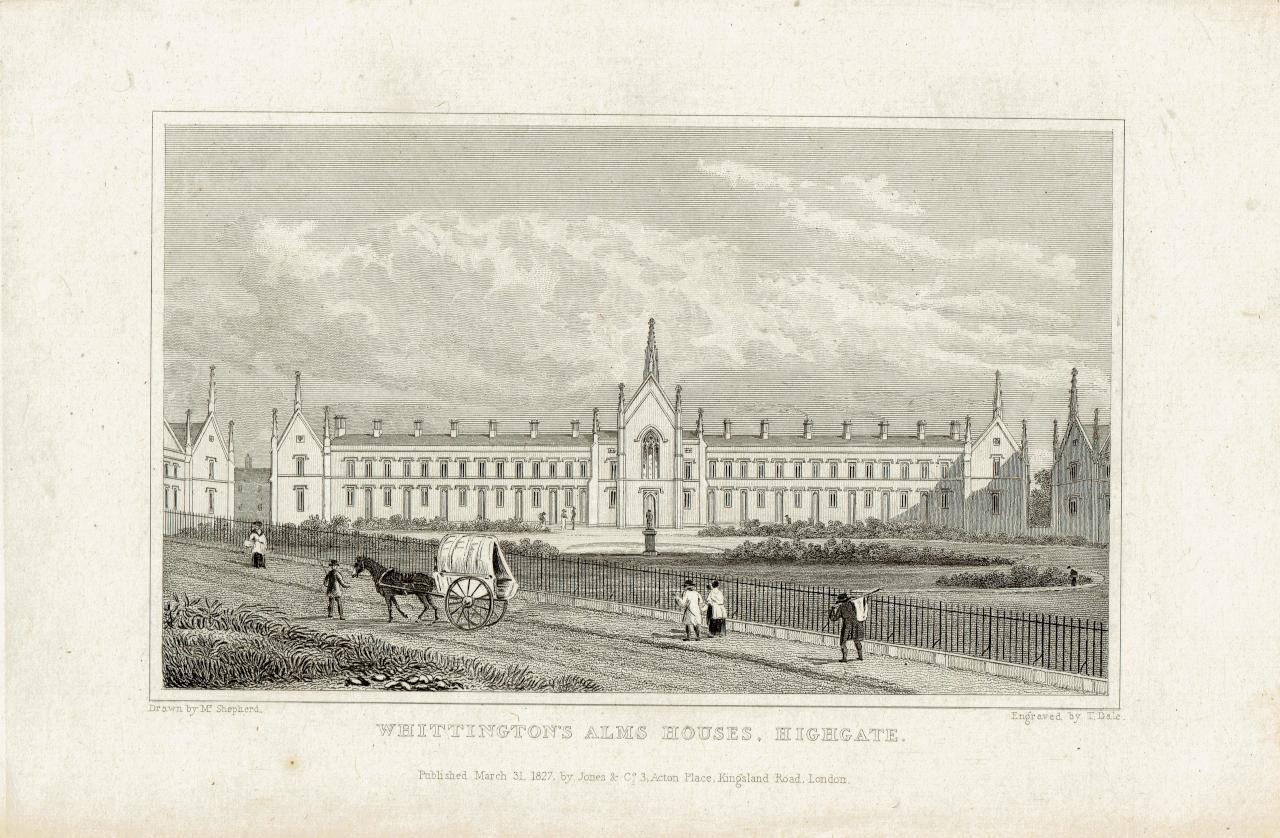This engraved book plate, 1827, drawn by Mr Shepherd, engraved by T Dale, is one of the 65 items in the Ruth Rogers Bequest. These almshouses are linked to a famous name. Dick Whittington, his cat and Highgate Hill are synonymous.

However, his was no rags to riches story as the nursery and pantomime tale tells us, nor did his cat have anything to do with his rise to fame and fortune. So much myth has gathered around his career that it is difficult to disentangle what is true.
Dick Whittington
Dick Whittington was born c.1356, the son of Sir William Whittington, a fairly wealthy Gloucestershire land owner. Richard married Alice, daughter of Sir Ivo Fitzwarren of Dorset, and died in 1423, having been Lord Mayor of London in 1397-98, 1406-07 and 1419-20, and Sheriff of London 1393-94. Whittington made a great deal of money as a mercer (fine textiles merchant) and he rebuilt the parish church he attended in the City, St Michael’s Paternoster, as Whittington College, a college of priests. He was Master of the Mercers’ Company three times and in his Will he charged this prestigious Livery Company with the administration of his college and of the land he owned.
Mercers’ Company
The college of priests was dissolved in 1547 during the Reformation and the Mercers’ Company built almshouses, also known as Whittington College, as a replacement, using funds from Sir Richard Whittington’s estates. By the beginning of the nineteenth century these were dilapidated and the Company decided to move them to a healthier site – six acres of land which it owned opposite the turnpike leading to Highgate Archway. This location was near the Whittington Stone on Highgate Hill, a reminder of the legend that Whittington had turned back to London here having heard Bow bells tell him that he would be Lord Mayor three times.
Work began on the new college in 1820 after soil from the building of Highgate Archway had been cleared. These larger almshouses, still named Whittington College, were designed by architect George Smith. They opened in 1824 at a cost of £20,000. Accommodation was provided for 24 single women, over the age of 55 at admittance, and with an annual income of less than £30, plus an annual stipend of £30. The 12 ladies who transferred from the City premises received more money, as well as a coal allowance. Provision was made for medical attention and nurses to care for them when ill. The premises also housed a chapel, the Matron, a nurse, a gardener and a chaplain. In 1860 the drainage was improved and by 1884 The Mercers Company had extended the building to accommodate thirty single women. Plans for rebuilding the almshouses were thwarted in 1962 by the Ministry of Transport’s decision to make Archway Road a dual carriageway.
The Mercers’ sold the almshouses and land to the London County Council (LCC). Demolition followed in 1967, land not taken by the new road becoming a public park. In the meantime, The Mercers’ Company had moved the ladies to the new Whittington College in Felbridge, neat East Grinstead where they remain part of that Company’s charitable provision.
Image credits
Hornsey Historical Society